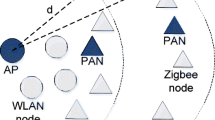Abstract
In next generation mobile networks, more and more throughput of network is required under the dense environment. There are some researches discuss how to solve the predicament of throughput. But they usually analyze it under the saturated environment. Most of their contention window size are also not optimal to fetch the maximum throughput. This paper is the first one to fetch the fixed optimal window size under the unsaturated environment which is closer to the real network. It is based on the Distributed Coordination Function (DCF) in Medium Access Control layer of IEEE 802.11 Wireless LAN to control the contention window size for reducing the collision problem and improving the throughput. A simplified one-dimension Markov Chain with a new idle state is proposed to simulate the unsaturated model. Then the formula of transmission probability under the unsaturated model and the equation which is used to fetch the optimized contention window size are analyzed. Comparing with the related analysis model in the simulation of the throughput and the collision rate. The result shows that the proposed model under unsaturated environment is better than before.
Access this chapter
Tax calculation will be finalised at checkout
Purchases are for personal use only
Similar content being viewed by others
References
802.11-1997-IEEE standard for wireless LAN medium access control (MAC) and physical layer (PHY) specifications. IEEE (1997)
IEEE 802.11-14/0165r1: P802.11ax task group press release (2014)
Hsiao, C.: Contention window size optimization and throughput analysis under the unsaturated environment of IEEE 802.11 DCF. Master thesis, Department of Electrical Engineering College of Electrical Engineering and Computer Science National Taiwan University (2013)
Deng, D.J., Chen, K.C., Cheng, R.S.: IEEE 802.11ax: next generation wireless local area networks
Deng, D.J., Ke, C.H., Chen, H.H., Huang, Y.M.: Contention window optimization for IEEE 802.11 DCF access control. IEEE Trans. Wireless Commun. 7(12), 5129–5135 (2008)
Bianchi, G.: Performance analysis of the IEEE 802.11 distributed coordination function. IEEE J. Sel. Areas Commun. 18(3), 535–547 (2000)
Author information
Authors and Affiliations
Corresponding author
Editor information
Editors and Affiliations
Rights and permissions
Copyright information
© 2018 ICST Institute for Computer Sciences, Social Informatics and Telecommunications Engineering
About this paper
Cite this paper
Sung, CH., Deng, DJ. (2018). Contention Window Size Adjustment in Unsaturated IEEE 802.11 WLANs. In: Lin, YB., Deng, DJ., You, I., Lin, CC. (eds) IoT as a Service. IoTaaS 2017. Lecture Notes of the Institute for Computer Sciences, Social Informatics and Telecommunications Engineering, vol 246. Springer, Cham. https://doi.org/10.1007/978-3-030-00410-1_1
Download citation
DOI: https://doi.org/10.1007/978-3-030-00410-1_1
Published:
Publisher Name: Springer, Cham
Print ISBN: 978-3-030-00409-5
Online ISBN: 978-3-030-00410-1
eBook Packages: Computer ScienceComputer Science (R0)




